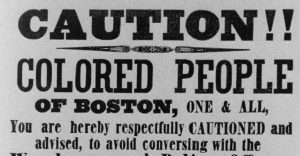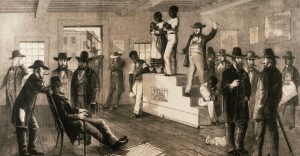In the narrative Running a Thousand Miles for Freedom: Or, the Escape of William and Ellen Craft from Slavery, William Craft utilizes epistles, allusions, and identity exploration to effectively illustrate the prejudice and inhumanity institutionally, socially, and fundamentally directed towards African-Americans in the United States during the mid-nineteenth century. The autobiographical tale focuses on an enslaved married couple who devise and partake in a successful escape from their master to the safety of the northern U.S., and then England, following the passage of the Fugitive Slave Act. Simultaneously incorporating the genre conventions of a slave narrative, Craft creates an emotional and powerful portrayal of a husband and wife desperately seeking the fundamental human right which was denied to them based solely off the pigment of their skin: freedom.
Above: Portraits of William and Ellen Craft, the couple at the center of Running a Thousand Miles for Freedom
One of the key epistles highlighted by the text is correspondence sent by Reverend Samuel May to Dr. Estlin in 1850. The letter is a vital component to building the narrative because it traces the events leading to the Craft’s narrow escape from slave-catchers in Boston to the safety of England. May comments on the tense political and racial landscape from which the Crafts need to flee, “[…] they nobly vindicated their title and right to freedom […] by winning their way to it; at least so they thought. But now, the slave power, with the aid of Daniel Webster […] has stimulated the slave-holders generally to such desperate acts for the recovery of their fugitive property, as have never before been enacted in the history of this government” (88 – 89). Furthermore, the arrest and legal charges brought against the slave-catchers attempting to recapture the Crafts contributes to the sense of political polarization evident between the North and South at this time, especially in the dawn of the Civil War. May’s point that the Crafts need to flee to “the shadow of the British throne” to pursue “life, liberty, and the pursuit of happiness” (91) underscores the hypocrisy underlying the American government’s support of slavery.
Along similar lines, William Craft includes allusions to political legislation which heavily influenced the trajectory of slavery and the legal rights (or lack thereof) of African-Americans and slaves during this time. For instance, Craft provides an in-depth summary of the legal rights of colored individuals in the Southern states, emphasizing the low legal status for blacks cemented by state laws found throughout states including Georgia, Tennessee, Missouri, Mississippi, and Kentucky. Craft’s descriptions of the extent of each law encapsulates the arbitrary natures of the laws themselves, as Craft points out: “[…] the slaveholders make it almost impossible for free persons of color to get out of the slave States, in order that they may sell them into slavery if they don’t go” (38 – 39). Moreover, the legislation reflects the far-reaching extent of the laws and the deeply ingrained inequalities composing the institution of slavery. Craft also mentions the Fugitive Slave Act and the Supreme Court’s infamous Dred Scott decision to contextualize the political climate and frame the government’s decades-long effort to oppress African-Americans and slaves.
Above: An 1851 flier posted around Boston, warning African-Americans and colored persons of the Fugitive Slave Act.
Additionally, Craft explores the identity of slaves as “chattel” in the narrative, particularly through descriptions of slave auctions. The slave auctions function as a vehicle to convey the inhumane objectification and violence faced by colored persons and slaves during this historical era; like merchandise, slaves were “brought to the auction stand and sold to the highest bidder” (19) as they were essentially recognized as “mere chattel, to be bought and sold, or otherwise dealt with as [their] owner might see fit” (30). The implications of the slave auctions—families being forcibly separated, the violent fates that awaited slaves following the sale, and the blatant cruelty exhibited by the white bidders—are an emotional appeal to the reader signifying the degree of brutality present in this commodification. Correspondingly, the widespread institutional disregard for the humanity and well-being of slaves completely dictated the political, social, and cultural realities for African-Americans in the United States.
Above: An illustration showing an 1861 slave auction in Virginia.
Each literary component of Craft’s autobiographical tale collectively builds to construct a taut, emotional narrative encapsulating the short- and long-term effects of the institution of slavery which pushed the Craft couple to execute a precarious escape from the barbarity of the Southern states pre-Civil War. Strategically integrating epistles, allusions, and identity exploration, Craft weaves a dynamic and dramatic chronicle of his experience which has grown to not only represent the horrors and tragic atrocities faced by countless individuals suffering under slavery but also the exhaustive lengths people took to escape from it.


